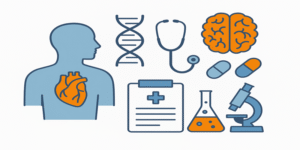In today’s data-driven economy, organisations are increasingly reliant on Business Analytics (BA) to make informed decisions, enhance efficiency, and gain competitive advantage. BA can be defined as the systematic exploration of data through statistical and computational methods to generate insights for decision-making (Evans, 2016). It is generally categorised into three types: descriptive analytics, predictive analytics, and prescriptive analytics, each serving a distinct but complementary role.
This article explores the foundations of BA, its categories, tools, and techniques, as well as its applications across industries such as healthcare, retail, and aviation. It also considers the challenges of implementation and outlines future directions shaped by big data, machine learning (ML), and artificial intelligence (AI).
The Core Types of Business Analytics
Descriptive Analytics
Descriptive analytics summarises past data to reveal patterns and trends. It involves reporting, visualisation, and statistical summaries, helping organisations understand what has already happened (Evans, 2016). For instance, a retailer may use sales dashboards to identify the best-performing product lines or seasonal demand fluctuations (Iyer & Iyer, 2025).
Predictive Analytics
Predictive analytics employs statistical modelling, regression analysis, and machine learning to forecast future outcomes (Vyas & Patel, 2025). Airlines such as British Airways use predictive analytics to forecast customer demand, optimise ticket pricing, and manage route profitability (Habib et al., 2025).
Prescriptive Analytics
Prescriptive analytics goes beyond forecasting by recommending optimal actions. It combines predictive models with optimisation algorithms to suggest strategies for maximising performance. For example, logistics firms use prescriptive analytics to determine the most efficient delivery routes, balancing costs and customer service (Joshua, 2025).
Tools and Techniques in Business Analytics
BA leverages a range of tools and methods, including:
- Data Mining – uncovering hidden patterns in large datasets.
- Statistical Modelling – using regression, correlation, and hypothesis testing for structured analysis (Wiranegara, 2025).
- Machine Learning (ML) – applying algorithms such as decision trees, clustering, and neural networks for classification and prediction (Cheriyan, 2025).
- Optimisation – solving mathematical models to determine the most efficient allocation of resources (Modalavalasa & Kali, 2025).
- Visualisation Tools – dashboards and BI platforms such as Tableau and Power BI, which present data in accessible forms (Jain, 2025).
For instance, Microsoft uses Power BI dashboards to integrate sales, marketing, and customer service data, enhancing real-time decision-making (Jain, 2025).
Applications Across Industries
Retail and E-commerce
Retailers like Tesco employ BA to track consumer purchasing patterns, manage supply chains, and personalise promotions (Rahman et al., 2025). Amazon applies predictive analytics to suggest products, improving cross-selling and upselling.
Healthcare
In healthcare, BA supports predictive modelling for disease outbreaks and patient risk analysis. Hospitals use prescriptive analytics to optimise resource allocation, such as ICU bed management during peak demand (Wu et al., 2025).
Finance and Banking
Financial institutions utilise BA for fraud detection, credit scoring, and risk management. Predictive models help banks anticipate loan defaults, while prescriptive models assist in portfolio optimisation (Thiyagarajan, 2025).
Aviation
Airlines like British Airways and Lufthansa use BA to optimise fuel consumption, flight schedules, and ticket pricing, significantly improving profitability and customer satisfaction (Habib et al., 2025).
Marketing
BA enables customer segmentation, campaign analysis, and sentiment analysis. Firms can track social media trends and customer feedback to shape marketing strategies (Ahmed, 2025).
The Role of Big Data and AI in Business Analytics
The rise of big data has revolutionised BA by enabling organisations to analyse massive, unstructured datasets from IoT devices, social media, and digital transactions (Modalavalasa & Kali, 2025). Artificial Intelligence (AI) enhances predictive and prescriptive analytics by enabling self-learning models capable of improving accuracy over time (Sabapathy, 2025).
For example, Netflix uses AI-driven analytics to recommend content to users, driving engagement and retention. Similarly, in manufacturing, predictive maintenance powered by BA minimises downtime by forecasting equipment failures.
Challenges in Business Analytics
Despite its transformative potential, BA faces key challenges:
- Data Quality – poor data integrity can undermine analytical accuracy (Pham, 2025).
- Integration Issues – combining structured and unstructured data from multiple sources is complex.
- Privacy Concerns – stricter regulations such as GDPR necessitate ethical and compliant use of customer data (Khalique, 2025).
- Skills Gap – organisations face shortages of professionals proficient in both analytics tools and business strategy (Cheriyan, 2025).
- Cost and Complexity – BA infrastructure requires significant investment in technology and skilled staff (Drvarek, 2025).
Future Directions
The future of BA is shaped by emerging technologies and methodologies:
- AI-Powered Analytics – deeper integration of machine learning for autonomous decision-making (Iyer & Iyer, 2025).
- Real-Time Analytics – increasing demand for streaming analytics in sectors like finance and e-commerce (Wu et al., 2025).
- Explainable AI (XAI) – ensuring that advanced predictive models remain transparent and interpretable (Sabapathy, 2025).
- Cloud-Based Analytics – scalable, flexible solutions accessible to firms of all sizes (Mamun, 2025).
- Industry-Specific Analytics – tailored solutions for healthcare, retail, and manufacturing.
For example, smart cities are applying BA integrated with IoT to improve traffic management, energy consumption, and environmental monitoring (Sudha et al., 2026).
Business Analytics is a critical enabler of informed decision-making, innovation, and sustainable growth in modern organisations. By integrating descriptive, predictive, and prescriptive analytics, firms can harness data to understand historical performance, anticipate future challenges, and take proactive measures. From retail to healthcare and aviation, BA has transformed operational efficiency and customer experience.
While challenges such as data quality, privacy, and skills gaps remain, the integration of AI, big data, and cloud computing promises to make BA more powerful, accessible, and impactful. For students and practitioners alike, understanding BA is essential for navigating the digital economy and leveraging data as a strategic asset.
References
Ahmed, S. (2025) Evolution and Importance of Business Analytics in Modern Business. ResearchGate. [Available at: https://www.researchgate.net/publication/379975634].
Cheriyan, V. (2025) Navigating the Analytics Landscape: A Comprehensive Guide for Recent Graduates. Journal of Computer Science and Technology. [Available at: https://al-kindipublishers.org/index.php/jcsts/article/view/9845].
Drvarek, S. (2025) Konceptualni model poslovne analitike korištenjem podatkovne analitike. Repozitorij Unin. [Available at: https://repozitorij.unin.hr/en/islandora/object/unin:7720].
Evans, J.R. (2016) Business Analytics: Methods, Models, and Decisions. 2nd ed. Pearson, Harlow.
Habib, M.A., Mahmood, A., Ahmad, M. & Baig, S.A. (2025) Barriers to Adoption Industry 4.0 in Textile Sector. IEEE Access. [Available at: https://ieeexplore.ieee.org/document/11129254].
Iyer, G.K.K. & Iyer, K.I. (2025) Future of Analytics: Are AI and ML Going to Replace Analytics as We Know It?. ResearchGate. [Available at: https://www.researchgate.net/publication/393412992].
Jain, R. (2025) Business Analytics Essentials You Always Wanted to Know. Business Books Publishing.
Joshua, C. (2025) Practical Approaches to Business Data Analytics for Competitive Advantage. ResearchGate. [Available at: https://www.researchgate.net/publication/392399475].
Khalique, S.A.A. (2025) Bulletin of Nexus. BNIR. [Available at: https://bnir.us/wp-content/uploads/0203011.pdf].
Mamun, M.N.H. (2025) Role of AI and Data Science in Data-Driven Decision Making for IT Business Intelligence: A Systematic Literature Review. ASRC Procedia. [Available at: https://global.asrcconference.com/index.php/asrc/article/view/23].
Modalavalasa, G. & Kali, H. (2025) Exploring Big Data Role in Modern Business Strategies. ResearchGate. [Available at: https://www.researchgate.net/publication/392927595].
Pham, N. (2025) Business Analytics-driven Sales & Operations Planning. Aalto University. [Available at: https://aaltodoc.aalto.fi/items/4156fbd7-4987-4aa8-9667-641745e55f81].
Sabapathy, G. (2025) AI-Powered Advanced Analytics: Transforming Data into Strategic Insights. Journal of Multidisciplinary Studies. [Available at: https://sarcouncil.com/2025/08/ai-powered-advanced-analytics].
Sudha, K., Pious, I.K., LA, A.G. & Divya, P. (2026) Leveraging Data Analytics for Informed Decision-Making in Process Management. IGI Global. [Available at: https://www.igi-global.com/chapter/386666].
Thiyagarajan, R. (2025) HR Analytics: Leveraging Data for Decision-Making in Human Resource Management. SSRN. [Available at: https://papers.ssrn.com/sol3/papers.cfm?abstract_id=5246906].
Vyas, A.R. & Patel, I.K. (2025) The Academic Research Issue. Research Review Online. [Available at: https://www.researchreviewonline.com/upload/articles/paper/RRJ206046.pdf].
Wiranegara, M.P. (2025) How Performance Analytics Drives Competitive Advantage in Modern Businesses. ResearchGate. [Available at: https://www.researchgate.net/publication/389439025].
Wu, M., Wang, K., Huang, H., Wu, X. & Liu, Z. (2025) From Big Data to AI-Driven Decisions in Obstructive Sleep Apnea: A Narrative Review. Nature and Science of Sleep. Taylor & Francis. [Available at: https://www.tandfonline.com/doi/abs/10.2147/NSS.S543091].









